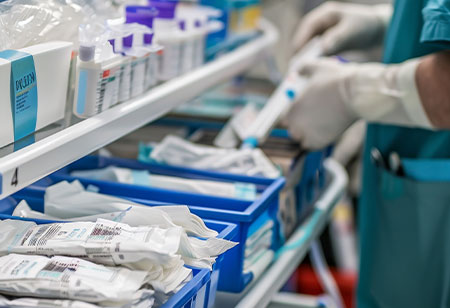
Understanding the distinct demand dynamics between retail and wholesale medical supplies is critical for stakeholders in the healthcare industry. These sectors play unique roles in meeting the needs of patients, healthcare providers, and facilities.
This article explores the key differences in demand dynamics, providing a comprehensive analysis for readers familiar with the healthcare supply chain.
Retail medical supplies are products sold directly to consumers, including patients and healthcare providers. These items cater to individual needs and are often available through:
• Pharmacies: Offering over-the-counter medications, personal protective equipment (PPE), and basic medical devices.
• Medical Supply Stores: Providing home-use medical equipment, mobility aids, and consumables.
• E-commerce Platforms: Growing rapidly as a convenient channel for purchasing medical supplies.
Retail focuses on fulfilling individual or small-scale needs, emphasizing accessibility and convenience.
Wholesale medical supplies involve the bulk distribution of products to entities such as hospitals, clinics, and long-term care facilities.
Wholesalers act as intermediaries between manufacturers and healthcare providers, ensuring a steady flow of essential supplies. Common examples of wholesale products include surgical instruments, hospital-grade PPE, and diagnostic equipment.
Several factors influence the demand for retail medical supplies:
• Consumer Health Trends: The prevalence of chronic diseases and a growing focus on preventive healthcare drive demand for products like blood pressure monitors and glucometers.
• Aging Population: As the population ages, there is an increased need for medical supplies like mobility aids and home-use diagnostic tools.
• Pandemic Influence: Events such as the COVID-19 pandemic have caused surges in demand for items like masks, gloves, and sanitizers, which are often fulfilled by online distributors like CIA Medical.
Retail demand is often reactive to societal trends and consumer awareness about health and wellness.
 Wholesale Demand Dynamics
Wholesale Demand DynamicsThe wholesale segment is shaped by institutional needs and operational requirements:
• Healthcare Facility Needs: Hospitals, clinics, and diagnostic labs require bulk medical supplies to ensure uninterrupted patient care.
• Regulatory Requirements: Adherence to safety and health regulations often necessitates consistent procurement of compliant medical products.
• Technological Advancements: New medical technologies lead to demand for updated supplies and equipment, such as advanced imaging devices.
Wholesale demand is more stable and predictable due to long-term contracts and institutional planning.
The retail supply chain focuses on delivering products to end-users efficiently. Key aspects include:
• Inventory Management: Retailers must carefully manage stock levels to avoid shortages or overstocking, which can lead to expired products.
• Supplier Relationships: Establishing reliable supplier networks ensures a consistent supply of products.
• Distribution Channels: Efficient logistics systems are critical for timely delivery, especially for e-commerce platforms.
The wholesale supply chain handles larger volumes and more complex logistics. Important factors include:
• Bulk Purchasing: Wholesalers procure large quantities of products, often negotiating better pricing with manufacturers.
• Storage Facilities: Proper warehousing ensures products are stored under appropriate conditions to maintain their quality.
• Distribution Networks: Robust networks are crucial for delivering supplies across regions to healthcare facilities and providers.
Retail pricing is influenced by several factors:
• Markup Rates: Retailers add a margin to cover costs and generate profit.
• Market Competition: A competitive environment can lead to price adjustments, making products more affordable for consumers.
• Consumer Willingness to Pay: Retailers assess what consumers are willing to spend and adjust prices accordingly.
Wholesale pricing dynamics differ significantly:
• Volume Discounts: Bulk purchases often come with significant per-unit cost reductions.
• Contractual Agreements: Long-term contracts can lock in favorable pricing for healthcare facilities.
• Market Demand: Fluctuations in demand can affect wholesale pricing, with high demand leading to price surges.
Both sectors must adhere to stringent regulations to ensure the safety and efficacy of medical products.
Retailers are responsible for:
• Product Authenticity: Ensuring all products are genuine and meet regulatory standards.
• Consumer Safety: Providing safe and reliable products for home use.
• Licensing Requirements: Maintaining proper licenses to sell medical supplies legally.
Wholesalers face additional compliance obligations:
Storage Standards: Adhering to specific storage conditions to preserve product quality.
• Traceability: Keeping detailed records to ensure products can be traced from manufacturers to healthcare providers.
• Distribution Regulations: Meeting legal requirements for the transportation and delivery of medical supplies.
Retail medical supplies are experiencing several notable trends:
• E-commerce Growth: Online sales platforms are increasingly popular, providing consumers with convenient access to a wide range of products.
• Health Awareness: Consumers are more informed about preventive care and actively seek products to support their health.
• Personalization: The market is shifting toward customized medical supplies to meet individual needs.
Wholesale markets are also evolving:
• Global Sourcing: Wholesalers are sourcing products internationally to offer a diverse range of medical supplies.
• Technological Integration: Advanced software for inventory management and distribution enhances efficiency.
• Supply Chain Optimization: Wholesalers are investing in technologies to streamline logistics and reduce costs.
Both retail and wholesale sectors face similar challenges:
• Supply Chain Disruptions: Events such as pandemics or geopolitical issues can disrupt supply chains, leading to shortages.
• Regulatory Changes: Evolving regulations require businesses to continuously adapt their operations.
• Market Competition: Increased competition puts pressure on profit margins and necessitates innovation.
Retailers can adopt several strategies to thrive in a competitive market:
• Customer Engagement: Building strong relationships with customers to understand their needs and preferences.
• Product Diversification: Expanding product lines to cater to a broader range of health requirements.
• Online Presence: Developing robust e-commerce platforms to reach a larger audience and improve accessibility.
For wholesalers, strategic focus areas include:
• Supplier Partnerships: Strengthening relationships with manufacturers to ensure reliable product availability.
• Efficient Logistics: Investing in logistics infrastructure to improve delivery times and reduce costs.
• Data-Driven Decisions: Using market analytics to anticipate demand and adjust inventory accordingly.
A regional pharmacy chain expanded its offerings to include durable medical equipment, such as mobility aids and home monitoring devices. This diversification led to higher customer satisfaction and a significant increase in sales.
A wholesale distributor implemented advanced inventory management software, reducing waste and improving order accuracy. This initiative resulted in a 15% increase in efficiency and higher customer retention rates.
Understanding the unique demand dynamics in retail and wholesale medical supplies allows businesses to align their strategies with market needs. By prioritizing compliance, leveraging technology, and responding to consumer and institutional demands, stakeholders can enhance their competitive edge.
We use cookies to ensure you get the best experience on our website. Read more...